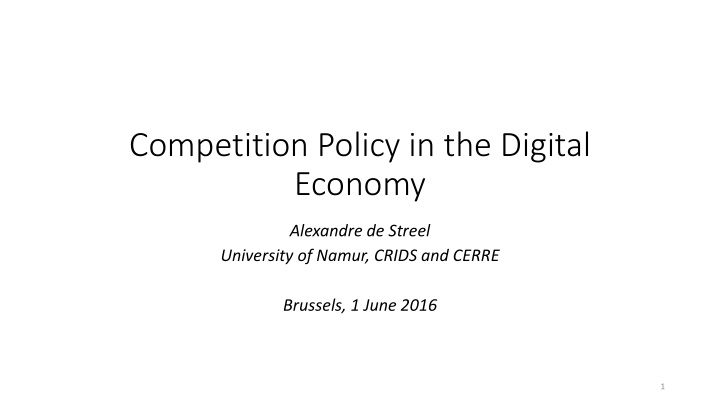



Competition Policy in the Digital Economy Alexandre de Streel University of Namur, CRIDS and CERRE Brussels, 1 June 2016 1
Dig igital Economy • A network economy • Multi-sided platforms • Big data • Which is evolving very fast • Innovation • Very quick 2
1. . Mult lti-sided pla latforms Source: P. Belleflamme 3
Im Impact on th theory ry of f harm • Fallacies of applying one-Sided Logic in Two-Sided Markets (Wright, 2003) • Should not focus on one-side of the market but have an holistic view • Size does not equal market power and may be good for consumers • Price benchmark: skewed price structure between both size • Risk is not so much in terms price increase, but in terms of • Discrimination: favoring its own products/services • Leverage: entering more easily new market segments 4
Big Data • Collection • Data is non-exclusive and non-rivalrous, short-lived, ubiquitous, inexpensive and easy to collect • BUT data collection can be limited by contractual restriction and/or hard to get (e.g. health data) • Storage • requires data centres (like ‘power plants’), that can be rented • Processing • based on deep learning algorithm • Feedback loops • User loop: more users more data better quality more users • Monetisation loop: more users/data more ads more investment more users/data • Thanks to direct and indirect network effects 5
Im Impact on th theory ry of f harm • Exploitative abuses in ‘free’ markets • Excessively low privacy protection (German Facebook case) • Exclusionary abuses • Refusal to give access to an essential facility (close to IMS case) • Leverage (French energy case, Belgian lottery case) • Raise rival costs • Discrimination • Against consumers • Against competitors ( Google case) 6
2. . In Innovation • Sustaining (within the same value network) • Incremental (erg VCR without slow motion with slow motion) • Breakthrough (e.g. VCR DVD Blu-ray) • Disruptive (outside the value network) • E.g. VCR/DVD/Blu-Ray Internet streaming • First performs worse and attracts new customers and then progress quickly to satisfy the need of the main customers 7
Im Impact on th theory ry of f harm • Structure-Conduct-Performance is outdated • Competition to change market boundaries • Conduct making the deployment of innovation more difficult or even impossible • Contestability • Access to consumers, interface more difficult • Downward innovation pressure • Ability and incentive to slow down innovation post merger 8
Im Impact on Process • Ex post antitrust • Intervention needs to be quick, while ensuring due process • Interim measures • Prima facie finding of antitrust infringement • Urgency due to the risk of serious and irreparable damage to competition • Commitments Decision • Opaque bargaining and no tested in Courts • Guidelines • Need to be based on tried and tested cases • Merger control • Pre-emptive merger cannot be screened by antitrust authorities • Additional notification threshold based on the value of the transaction 9
Take-Away • Be cautious but not passive • Antitrust tools are sufficiently flexible • to incorporate technology, market and business models innovations based on network effects • Provided they are well understood • A shift of approach • From market definition to theory of harm • From price evolution to innovation incentives • From static efficiency to dynamic efficiency • A new focus • leverage and discrimination • contestability and downward innovation pressure • A new rhythm 10
More recommend